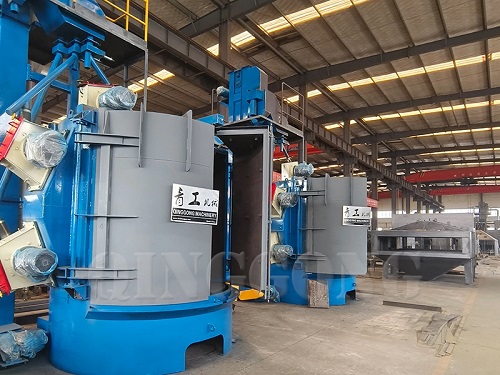When we design the dust collector for sandblasting room, we need to pay special attention to the following three items, because they are related to the dust removal effect of the sandblasting room:
1. Three kinds of abrasives and dust commonly used in sandblasting rooms
There are three types of abrasives we normally use: steel shot, garnet and river sand.
The amount of dust produced by these three abrasives is different when blasted. Steel shot has the smallest amount of dust, river sand has the largest amount of dust, and garnet is in the middle. Because of the different amounts of dust, it needs different equipment and air volume in the same volume.
2. Two ways to calculate air volume in sandblasting room
For the sandblasting room, there are two ways to calculate the air volume:
(1) We can estimate according to the dust concentration of the volume of the entire blasting room or calculate the number of air changes per minute through our formula so that we can get the number of air changes in the sandblasting room and get the entire air volume. The number of air changes for the steel shot ranges from 120 to 150.
(2) Through the calculation of the cross-sectional area, the air volume can be calculated by ensuring the absorption of dust in the blasting room. We calculate by the cross-sectional area because we all need to know that the dust in the blasting room does not require excessive negative pressure. The most important thing is to prevent the dust from spilling out of the door. It only needs to generate a certain amount of negative pressure inside. The dust can be naturally settled in the sandblasting room or at the suction port, and it can be discharged to the outside into the dust collector for filtering.
We usually calculate the cross-sectional area by multiplying the length by the height. We can use ordinary calculation formulas, but we must pay attention to the selection of its filtering wind speed. We can take as low as 0.2 or 0.3, so as to ensure that its air volume is within a reasonable range.
3. Precautions for selecting air outlet
Here is a reminder for everyone about the precautions of the outlet. In fact, there are regulations for the air inlet. The air inlet should not be too small. If it is too small, the air inside cannot be replaced by fresh air, so the suction effect in the sandblasting room will become poor.
If the air inlet is too large, the dust will cause spillage. This air inlet needs to be calculated by us. And if we use an axial fan to make up the air inside the blasting room, we must pay attention to the tangential direction of the wind, so that the dust cannot be discharged due to the rotation in the blasting room.
 EN
EN
 fr
fr  de
de  es
es  it
it  ru
ru  pt
pt  ar
ar  th
th  pl
pl  ro
ro 


